The future is urban. Currently, more than half the people in the world live in cities, which account for more than 80% of global GDP.
The rapid urbanisation megatrend is the story of where most of us live.
By 2050, just over two thirds of humanity will be urban dwellers.
Cities are engines of creativity and innovation, and most urban dwellers experience higher standards of living than those in rural areas.
Cities can also be more efficient in terms of land use, and the distribution of resources.
Yet, one in three urban residents lives in a slum household.
Cities cover only 2% of the world’s land surface, but activities within their boundaries consume more than three quarters of the world’s resources.
Poorly planned urbanisation is a key driver of CO2 emissions.
Urbanisation is occurring at different rates around the world: The UN says the bulk of urban growth will happen in the cities of developing nations.
Eight out of ten of the world’s most populous cities are currently in Asia.
By the next century, 13 of the largest megacities are predicted to be in Africa, and three will be in India. None of the top 20 will be found in America, China, or Europe, as ageing populations shrink large cities in these regions.
Africa will also feature the world’s largest urban agglomeration – by the end of the century, half a billion people will live in the nearly 1,000 kilometre stretch from Lagos in Nigeria to Abidjan in Côte d’Ivoire.
While urbanisation creates huge opportunities for smart, eco-friendly cities, it also makes demands on infrastructure, the environment, and the provision of jobs and services, especially in developing economies. Increased density and an ageing population mean we need to rethink healthcare and public services to better share urban spaces.
More congested cities pose climate change challenges from rising emissions, but also offer potential solutions. This megatrend is an opportunity to develop low carbon and resource efficient cities of the future. We will need to ensure that future cities offer a decent standard of living and increased opportunities for the people living in them.
The World Bank (2023). Urban Development. Available at:
https://www.worldbank.org/en/topic/urbandevelopment/overview
Ritchie, H., Roser, M. (2019). Urbanization, Our World in Data. Available at:
https://ourworldindata.org/urbanization
UN Habitat (2018). Land Use Efficiency, United Nations Human Settlement Programme. Available at: https://unhabitat.org/sites/default/files/2021/08/indicator_11.3.1_training_module_land_use_efficiency.pdf
Venditti, B. (2022). ‘This chart shows the impact rising urbanization will have on the world’, Visual Capitalist. Available at:
https://www.weforum.org/agenda/2022/04/global-urbanization-material-consumption/
Desjardins, J. (2018). ‘World’s Largest Megacities by 2100’, Visual Capitalist. Available at:
https://www.visualcapitalist.com/worlds-20-largest-megacities-2100/
French, H.W. (2022). ‘Megalopolis: how costal west Africa will shape the coming century’, The Guardian 27/10/22. Available at: https://www.theguardian.com/world/2022/oct/27/megalopolis-how-coastal-west-africa-will-shape-the-coming-century
United Nations’ Department of Economic and Social Affairs (2018). ‘Around 2.5 billion more people will be living in cities by 2050’. Available at:
https://www.un.org/en/desa/around-25-billion-more-people-will-be-living-cities-2050-projects-new-un-report
World Population Review (2023). ‘Largest Metro Areas in the World’. Available at:
https://worldpopulationreview.com/world-city-rankings/largest-metro-areas-in-the-world
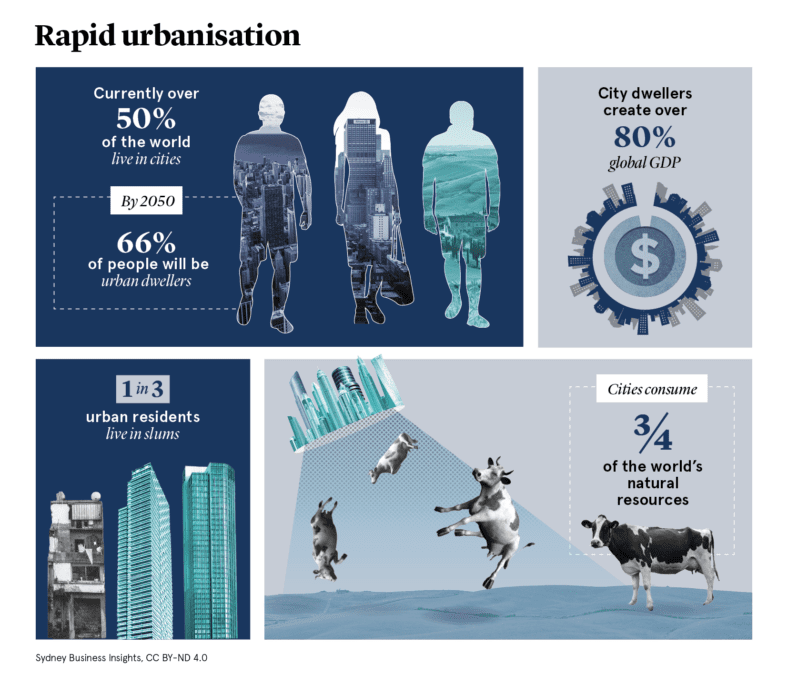
We believe in open and honest access to knowledge.
We use a Creative Commons Attribution NoDerivatives licence for our articles and podcasts, so you can republish them for free, online or in print.
The latest on rapid urbanisation
Archive
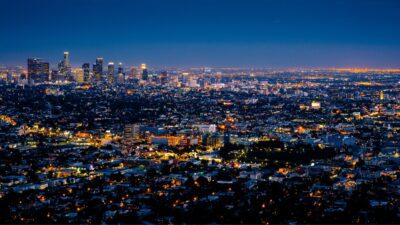
Global cities as future drivers of international business activities
Cities contribute more than 80% of global GDP, but how can they attract innovative and sustainable businesses?

The death of the smart city
The smart city has been the dazzling promise in urban planning for the last 20 years, but is the idea failing?
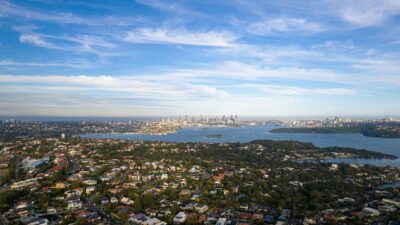
Welcome to Sydney 2036, how is the 3 part city working?
What does life look like for a 36 year-old Sydney resident in 2036?
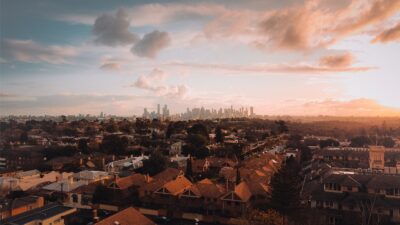
Essential workers a long way from home
People working in lower paid but highly essential services cannot afford to live near our city centres.
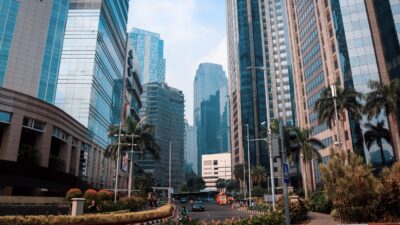
The North-South divide in smart city development
Smart cities continue to spread, but how is the North-South divide impacting development in the Global South?

Cities are on the frontline of climate change – prepare or perish
More than 800 million people could be affected by coastal flooding, how are cities adapting?
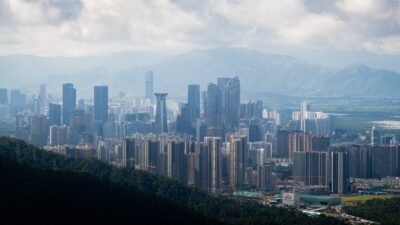
A tale of two megacities
Cities with affluent residents – and corresponding high consumption lifestyles, account for the largest carbon footprints.

Cramming cities full of electric vehicles means we’re still depending on cars — and that’s a huge problem
Electric vehicles deserve government subsidies, but there are even better ways to build greener, less car-dependent cities.

Smart street furniture in Australia: a public service or surveillance and advertising tool?
The data collection and surveillance capabilities of smart street furniture raise a number of concerns.

How Australians’ commutes compare with cities overseas
A global study of 117 cities finds Australian capitals have fairly poor access by car. Public transport, cycling and walking access isn't as good as in Europe and China.

AirTags and suburban retrofitting on The Future, This Week
This week: Apple’s AirTag release raises platform competition issues, and the trend of suburban retrofitting changes what suburbs are for.

Changing cities on Corona Business Insights
How are cities changing and adapting during the pandemic? We talk with urban geographer Dr Dallas Rogers on how COVID-19 is reshaping urban areas.
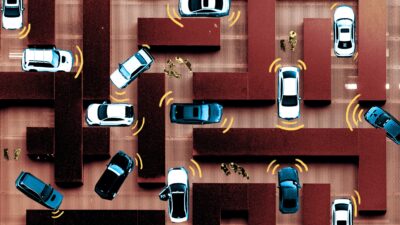
Autonomous vehicles and self-driving cars on The Future, This Week
This week: after a flurry of contradicting announcements, we discuss if self-driving cars have finally arrived, or what it would take to get them here.

The Future, This Week 14 Jun 19: #FlyingCars, #Mobility, #EVs
This week: Flying cars, China pushes electric vehicles, and the future of the automobile.

How close is Sydney to the vision of creating three 30-minute cities?
The Greater Sydney Commission has proposed a 40-year vision of a metropolitan region formed of three “cities”: the Eastern “Harbour” City, the Central “River” City, and the Western “Parkland” City.
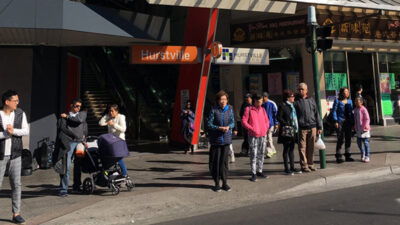
How Australian cities are adapting to the Asian Century
China’s rise as a global power is driving new flows of people, ideas and capital between China and Australia. Australian cities need to adapt to this new geopolitical reality.

Reimagining Sydney: this is what needs to be done to make a Central City CBD work
Central City 2048 proposes one new rail line, three metro lines and almost 300,000 extra jobs for the new CBD, one of three proposed for metropolitan Sydney. Clearly, the investment needed is massive.
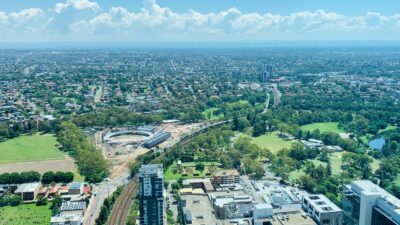
Re-imagining Sydney with 3 CBDs: how far off is a Parramatta CBD?
The Greater Sydney metropolis is envisaged as having three CBDs by mid-century, but an assessment of the proposed Central City around Parramatta shows how much work is needed to make that a reality.

The Future, This Week 28 Sep 18: space measurements, liveability, and privacy (not)
This week: measure from space, liveable cities, and privacy is not the issue.

Making small cities bigger will help better distribute Australia’s 25 million people
In the 70s, Whitlam tried to build new, big cities. But this was too costly. Now the most viable solution for Australia's population woes is to make existing cities bigger.

Aim for cities of all sizes to give everyone a fair go
Having cities of all sizes will increase people's choices of where to live and work.

Why the need for speed?
We spend on average about an hour a day travelling. Given this is unlikely to change, how can we make this time more productive and enjoyable?
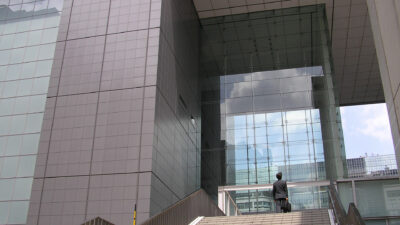
Feeling lonely
Employee loneliness hurts companies.

Creating safer cities
Security in cities can make some people feel safe while excluding others. New ways of planning and policing public space are needed to ensure cities are safe and accessible for all.

The Future, This Week 27 April 2018
This week: what we learn from digital business, feeling lonely, and making rain the size of Spain in other news.
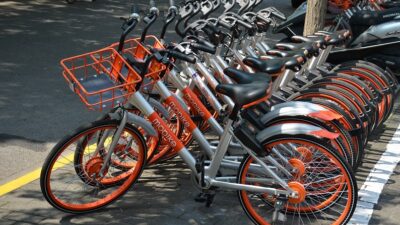
China’s “Internet of Bikes”
The golden era of automobility innovation: the “Internet of Bikes” sensation in China.

Coming soon: The Future, This Week Season 3
Season 3 of The Future, This Week is coming next week!

The Future, This Week 22 December 2017
The Future, This Year: the most interesting, the weird and the wonderful, what's in store for 2018, and a Christmas story.

The Future, This Week 24 November 2017
This week: is the ivory tower asleep at the wheel, city experiments, and Uber...again.
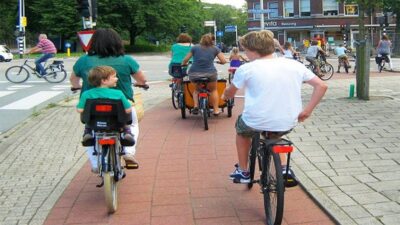
People take to their bikes when we make it safer and easier for them
The evidence suggests a small investment in cycling infrastructure, combined with less punitive policing, would enable more Australians to escape daily traffic congestion.

Capturing China’s middle class potential
The emergence of China's middle class is one of the greatest economic stories of the 21st century and a game changer for the global markets.

Putting cities back into ‘smart cities’
Amidst growing fascination with the promise of digital technologies, do we really understand how to think strategically about cities?





